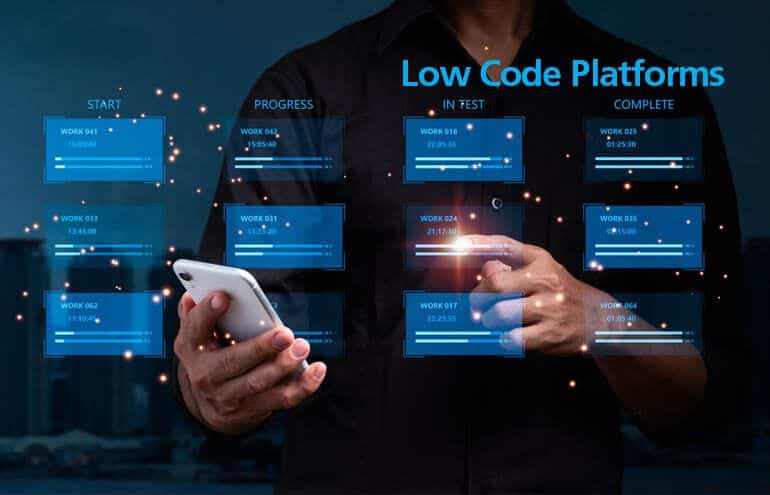Low code is taking the corporate world by storm — and changing the way the legal community carries out work. Here’s how legal teams are using no-code tools to improve their efficiency and effectiveness.
Table of contents
For nearly half a century, we have been able to use our personal computers without having to write a single line of code. And more recently, we have been able to create entirely new software and associated applications — like those for contract management and corporate governance — thanks to the evolution of low- or no-code technology.
Traditionally, developing technology and platform features fell to developers and programmers alike. This gave general users very limited — if any — say in development processes. But nowadays, general users, or “citizen developers,” are able to build an array of technology solutions thanks to low-code platforms. We, as professionals, can produce websites from scratch, customize their appearance, and add responsive and interactive features. Think Wix and WordPress. We can develop apps that work seamlessly and locally on our mobile devices. What’s more, we can embed artificial intelligence into current apps to perform an in-depth analysis of data and create automated workflows for everything from invoices to contracts and other legal documents.
Although it is relatively new, the global low- and no-code markets have grown due to remote work accelerated by the COVID-19 pandemic. In fact, they have more or less exploded, totaling more than $13 billion in 2021, according to Gartner. Gartner also predicts that by 2024, 65% of all app development will be done with low code.
With that, let’s explore what low code is exactly and how it benefits the legal community in particular.
What Is Low Code?
Essentially, low code is a type of software development allowing non-programmers and programmers alike to use a graphical user interface instead of writing code manually. It is based on the fundamental idea that technology should facilitate software creation and not be a barrier to entry.
More specifically, the low-code approach takes basic code and transforms it into easy, drag-and-drop app components. This means software creators can build modern apps simply and visually. (This also means those who have the knowledge of institutions and understanding of business requirements no longer need a set of programming skills.) Naturally, coding for customizations or very specific use cases still happens behind the scenes. But low-code tool makers use data abstraction and encapsulation to make everything easy for everyday users.
Like low-code development, no code relies on a visually integrated development environment. The main difference between the two is that no-code platforms provide the building blocks that every app needs. They are then brought together in users’ apps through easily understood commands that require no coding whatsoever. (In other words, you can draw a fine line between no-code and low-code technology.)
Think of implementing platforms with low- or no-code technology like constructing a house right next to a hardware store — one that has all the right materials and function-specific tools. Building either of these is smoother and quicker than what is typically possible.
How Can the Legal Industry Benefit From Low Code?
Low-code platforms empower legal professionals with little or no coding expertise to be software and application creators. But this approach to technology development holds specific value for legal teams, such as the following.
Speedy Deployment
The initial benefit of low-code technology is its ability to be deployed quickly. Traditional enterprise systems can take months or even years to implement in large organizations. However, no-code technology platforms simplify and streamline the app-building process as they eliminate the need for manual coding. As a result, apps can be developed according to specific workflows in a matter of hours.
Adaptability and Customization
By design, no-code software is highly configurable. Whatever the size of the organization — whatever the business processes or workflows — it is adaptable to a legal department or practice’s evolving needs. That’s because no-code software is meant to enhance the experience of a wider and wider user base.
User-Friendliness
Another benefit of no-code platforms over code-heavy systems is their user-friendliness. Think straightforward, browser-based interfaces combined with the latest chatbots, for example. Thanks to these features, legal teams can be tasked with developing and managing no-code platforms on their own.
Ultimately, this means that legal teams — as citizen developers — will see fewer production costs and less initial training, and experience greater autonomy.
This also means traditional developers, with deeper technical backgrounds, no longer have to write massive amounts of code themselves. They can instead dedicate their time to meaningful technology projects.
The Future of Low Code
Given that in-house legal teams typically find themselves strapped for resources and time, the future of low-code platforms is rather bright. The former can implement the latter to receive the full power of AI and automation, without demanding more IT hands on deck. The same is true for innovative law firms and companies. Low code is not only a novel way to build applications, but also a fundamental shift in who can build them. The technology has reached the proverbial tipping point, allowing us to mirror the work of technology developers day to day.
And to think, low-code platforms will become more powerful, intuitive and easy to use with each passing year. This will make the software more accessible and universal than ever before.
Image © iStock.com
Subscribe to Attorney at Work
Get really good ideas every day for your law practice: Subscribe to the Daily Dispatch or the Weekly Wrap (it’s free).























